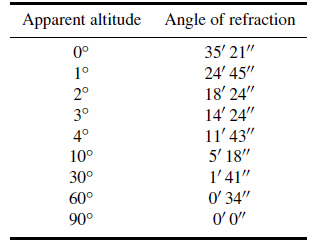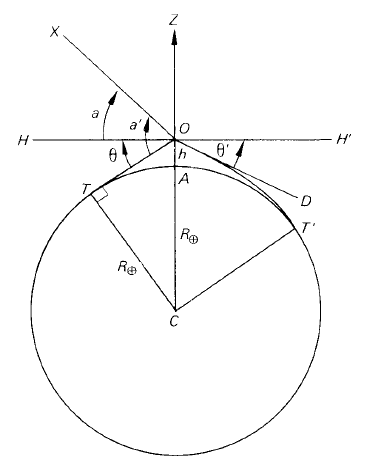


 الفيزياء الكلاسيكية
الفيزياء الكلاسيكية
 الكهربائية والمغناطيسية
الكهربائية والمغناطيسية
 علم البصريات
علم البصريات
 الفيزياء الحديثة
الفيزياء الحديثة
 النظرية النسبية
النظرية النسبية
 الفيزياء النووية
الفيزياء النووية
 فيزياء الحالة الصلبة
فيزياء الحالة الصلبة
 الليزر
الليزر
 علم الفلك
علم الفلك
 المجموعة الشمسية
المجموعة الشمسية
 الطاقة البديلة
الطاقة البديلة
 الفيزياء والعلوم الأخرى
الفيزياء والعلوم الأخرى
 مواضيع عامة في الفيزياء
مواضيع عامة في الفيزياء|
Read More
Date: 22-8-2020
Date: 28-7-2020
Date: 5-9-2020
|
Atmospheric refraction: Horizontal refraction
When the Sun or Moon is observed rising or setting, the observed zenith distance of its centre is 90◦. For such a zenith distance, the refraction amounts to 35' and is called the horizontal refraction. Since the angular diameter of these bodies is about 30', they are, in fact, below the horizon when their centres are seen to be on the horizon. In the case of the Sun, therefore, horizontal refraction lengthens the time interval during which it is daylight, sunrise and sunset taking place earlier and later respectively than they would occur if refraction were absent. Tables which provide accurate sunrise and sunset times for any location take account of horizontal refraction.
Table 1 shows how quickly refraction diminishes with altitude. Because of this, an extended body like the Sun is decidedly oval in shape near rising and setting, the refraction of the upper and lower limbs being different.
Table 1. Variation of apparent altitude with angle of refraction.


Figure 1. The angle of dip.



|
|
|
|
دخلت غرفة فنسيت ماذا تريد من داخلها.. خبير يفسر الحالة
|
|
|
|
|
|
|
ثورة طبية.. ابتكار أصغر جهاز لتنظيم ضربات القلب في العالم
|
|
|
|
|
|
|
سماحة السيد الصافي يؤكد ضرورة تعريف المجتمعات بأهمية مبادئ أهل البيت (عليهم السلام) في إيجاد حلول للمشاكل الاجتماعية
|
|
|